
The flute is a family of classical music instrument in the woodwind group. Like all woodwinds, flutes are aerophones, meaning they make sound by vibrating a column of air. However, unlike woodwind instruments with reeds, a flute is a reedless wind instrument that produces its sound from the flow of air across an opening. According to the instrument classification of Hornbostel–Sachs, flutes are categorized as edge-blown aerophones. A musician who plays the flute is called a flautist or flutist.

A shakuhachi is a Japanese and ancient Chinese longitudinal, end-blown flute that is made of bamboo.

The nose flute is a musical instrument often played in Polynesia and the Pacific Rim countries. Other versions are found in Africa.

A bansuri is an ancient side blown flute originating from the Indian subcontinent. It is an aerophone produced from bamboo and metal like material used in Hindustani classical music. It is referred to as nadi and tunava in the Rigveda and other Vedic texts of Hinduism. Its importance and operation is discussed in the Sanskrit text Natya Shastra.
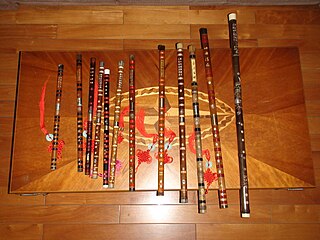
The dizi, is a Chinese transverse flute. It is also sometimes known as the di or héngdi, and has varieties including Qudi, Bangdi, and Xindi. It is a major Chinese musical instrument that is widely used in many genres of Chinese folk music, Chinese opera, as well as the modern Chinese orchestra. The dizi is also a popular instrument among the Chinese people as it is simple to make and easy to carry.
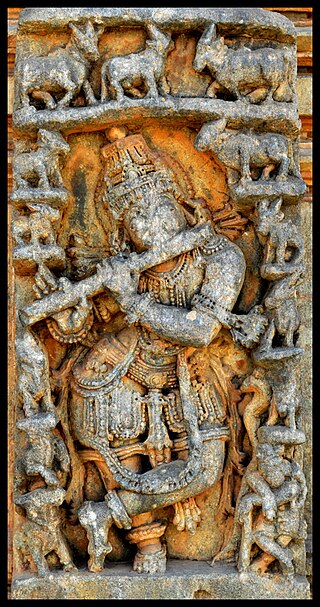
The bamboo flute, especially the bone flute, is one of the oldest musical instruments known. Examples of Paleolithic bone flutes have survived for more than 40,000 years, to be discovered by archaeologists. While the oldest flutes currently known were found in Europe, Asia too has a long history with the instrument that has continued into the present day. In China, a playable bone flute was discovered, about 9000 years old.

The kaval is a chromatic end-blown flute traditionally played throughout the Balkans and Anatolia. The kaval is primarily associated with mountain shepherds.

The suling or seruling is a musical instrument of the Sundanese people in western Java, Indonesia. It is used in the Degung ensemble. Bamboo ring flute can also be found in Southeast Asian, especially in Brunei, Indonesia, Malaysia, the Philippines and Singapore.
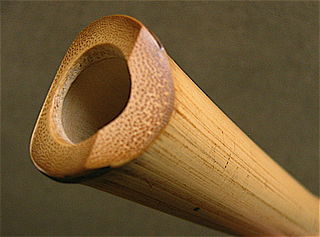
The hotchiku, sometimes romanized as hocchiku or hochiku, is a Japanese aerophone, an end-blown bamboo flute, crafted from root sections of bamboo. The bamboo root is cleaned and sanded, resulting in a surface patterned with many small, circular knots where the roots formerly joined the stalk. The same part of the bamboo plant is also used to produce the shakuhachi but, unlike the shakuhachi, the hotchiku's inside (bore) and outside surfaces are left unlacquered, and an inlay is not used in the mouthpiece. The membranes at the nodes inside a hotchiku bore are generally left more intact than those of a shakuhachi, though older komuso shakuhachi also share this trait. Together, these characteristics make for a visibly and audibly raw and organic instrument. Hotchiku are sometimes referred to as jinashi nobekan, meaning "without ji [a paste made of clay and lacquer, used to smooth the bore on modern shakuhachi], one-piece"; hotchiku are not cut in two pieces for crafting or storage, unlike modern shakuhachi that are used as musical instruments.

Mizoram is a region in India. Its folk music consists of vocals (singing) accompanied by traditional drums, gong and other native percussion instruments. There is also a long history of flute-playing which is now defunct. The drums are made from a hollow tree trunk with membrane made from cow hide and the gongs, made of brass, are very similar to those found in Myanmar.

Tripura is a state of India that has produced a wide variety of folk music. The musician Hemanta Jamatia gained major renown beginning in about 1979, when he became a musical representative for the separatist Tripura National Volunteers. He later on surrendered and returned to normal life, dedicating his work to the folk music of the Tripuri people. In recognition of his contributions to folk and modern music in the Tripuri language, he was awarded the highest honour in the field of music by the Government of India's Sangeet Natak Academy.
The venu is one of the ancient transverse flutes of Indian classical music. It is an aerophone typically made from bamboo, that is a side blown wind instrument. It continues to be in use in the South Indian Carnatic music tradition. It is referred to as nadi and tunava in the Rigveda and other Vedic texts of Hinduism. In northern Indian music, a similar flute is called bansuri. In the south, it is also called by various other names such as pullanguḻal (புல்லாங்குழல்) in Tamil, oodakuḻal (ഓടകുഴൽ) or kurungu kuḻal in Malayalam (Kerala) and ಕೊಳಲು (koḷalu) or ಮುರಳಿ (muraļi) in Kannada (Karnataka). It is known as pillana grōvi or vēṇuvu (వేణువు) in Telugu. It is also called as Carnatic Flute.
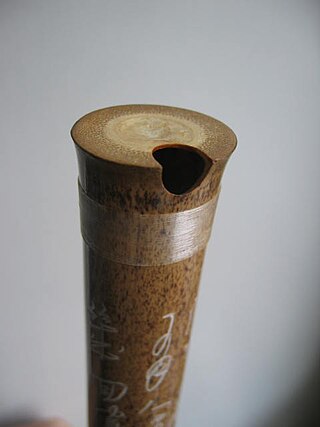
The xiao is a Chinese vertical end-blown flute. It is generally made of bamboo. It is also sometimes called dòngxiāo, dòng meaning "hole." An ancient name for the xiāo is shùzhúdí but the name xiāo in ancient times also included the side-blown bamboo flute, dizi.
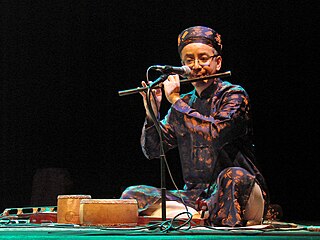
The sáo is a family of flutes found in Vietnam that is traditionally thought to contain the culture and spirit of Vietnam's countryside. The most common variety is played with the flutist holding the sáo transversely to the right side with his or her mouth placed at the blowing hole. Other varieties include the Sáo Dọc, a kind of recorder similar to the Thai Khlui, the Sáo Bầu, and the Sáo ôi, a recorder played by the Muong people. The sáo is usually performed solo or in an ensemble among other instruments in orchestras of Vietnamese popular opera Chèo, Van singing genre, and Royal Small Orchestra.

The quray is a long open endblown flute with two to seven fingerholes, and is the national instrument of the Bashkirs and Tatars. The instrument is a type of Choor. On March 1, 2018 Kurai was registered as a territorial brand of Bashkortostan, a patent was received from the Federal Service for Intellectual Property of the Russian Federation.
A kalaleng is a nose flute made from bamboo from the Philippines.
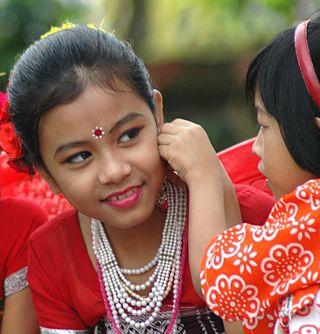
The culture of Tripura is distinct and a bit similar to other people of Northeast India. However like Assam, Manipur, Burma and Southeast Asia culture of Tripura is characterized in small portion where people live in plain and hill areas. Tripura is a state in North East India. In the 2001 census of India, Bengalis represented almost 70% of the population and the Tripuri population comprised 30% of Tripura's population. The Tripuri population comprises some clans and ethnic groups with diverse languages and cultures. The largest native group was the Tripuri who had a population of 543,848 in 2001 census, representing 16.99% of the state population and 54.7% of the scheduled tribe population. The other group of people in order of decreasing population were Chakma (6.5%), Halam (4.8%), Mog (3.1%), Munda, Kuki tribes and Garo Hajong. Bengali is the most spoken language, due to the dominance of Bengali people in the state. Kokborok (Tripuri/Tiprakok) is a common language among Tripuris and lingua franca in Tripura. Several other languages belonging to Indo-European and Sino-Tibetan families are spoken by the different tribe

A kuisi is a Native Colombian fipple flute made from a hollowed cactus stem, with a beeswax and charcoal powder mixture for the head, with a thin quill made from the feather of a large bird for the mouthpiece. Seagull, turkey and eagle feathers are among the feathers commonly used.
Lebang Boomani dance is a harvest dance performed by the Tripuri people of Tripura, India. It is one of two dances associated with the Tripuris, the other being the Garia dance that is performed at the time of sowing crops.

Sundanese Music is an umbrella term that encompasses diverse musical traditions of the West Java and Banten in western part of Java, Indonesia. The term of "West Java" is preferred by scholars in this field. The word "Sundanese" originally referred to western part of Java Island and has a strong association with the highly centralized Sunda Kingdom based on Java Island and its high culture practiced by the nobleman class in its capital Parahyangan. By contrast, scholars who cover a much broader region lay emphasis on folk culture.















